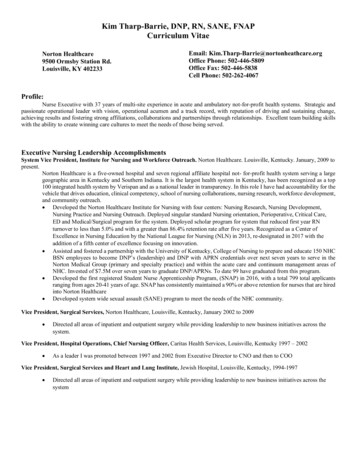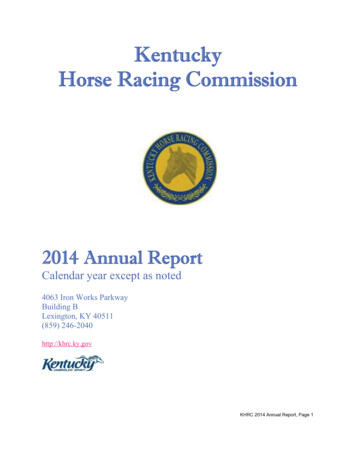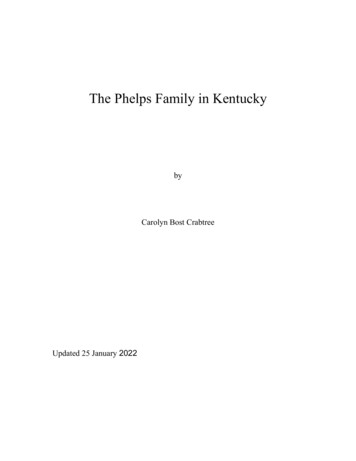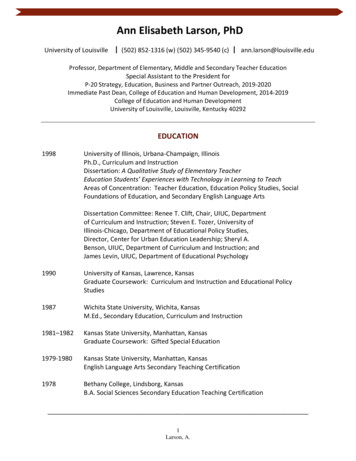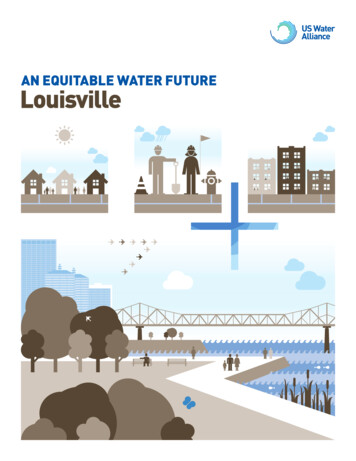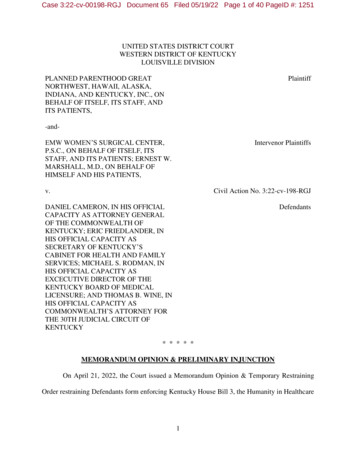
Transcription
Case 3:22-cv-00198-RGJ Document 65 Filed 05/19/22 Page 1 of 40 PageID #: 1251UNITED STATES DISTRICT COURTWESTERN DISTRICT OF KENTUCKYLOUISVILLE DIVISIONPLANNED PARENTHOOD GREATNORTHWEST, HAWAII, ALASKA,INDIANA, AND KENTUCKY, INC., ONBEHALF OF ITSELF, ITS STAFF, ANDITS PATIENTS,Plaintiff-andEMW WOMEN’S SURGICAL CENTER,P.S.C., ON BEHALF OF ITSELF, ITSSTAFF, AND ITS PATIENTS; ERNEST W.MARSHALL, M.D., ON BEHALF OFHIMSELF AND HIS PATIENTS,Intervenor Plaintiffsv.Civil Action No. 3:22-cv-198-RGJDANIEL CAMERON, IN HIS OFFICIALCAPACITY AS ATTORNEY GENERALOF THE COMMONWEALTH OFKENTUCKY; ERIC FRIEDLANDER, INHIS OFFICIAL CAPACITY ASSECRETARY OF KENTUCKY’SCABINET FOR HEALTH AND FAMILYSERVICES; MICHAEL S. RODMAN, INHIS OFFICIAL CAPACITY ASEXCECUTIVE DIRECTOR OF THEKENTUCKY BOARD OF MEDICALLICENSURE; AND THOMAS B. WINE, INHIS OFFICIAL CAPACITY ASCOMMONWEALTH’S ATTORNEY FORTHE 30TH JUDICIAL CIRCUIT OFKENTUCKYDefendants* * * * *MEMORANDUM OPINION & PRELIMINARY INJUNCTIONOn April 21, 2022, the Court issued a Memorandum Opinion & Temporary RestrainingOrder restraining Defendants form enforcing Kentucky House Bill 3, the Humanity in Healthcare1
Case 3:22-cv-00198-RGJ Document 65 Filed 05/19/22 Page 2 of 40 PageID #: 1252Act of 2022 [DE 1-1 (“HB 3”)].1 [DE 27]. Plaintiff Planned Parenthood Great Northwest, Hawaii,Alaska, Indiana, and Kentucky, Inc., (“Planned Parenthood”) moves for a preliminary injunction[DE 3] to block the enforcement of HB 3. Intervening Plaintiff EMW Women’s Surgical Centerand Dr. Ernest W. Marshall (“EMW” and together with Planned Parenthood, “Plaintiffs”) alsomoves for a preliminary injunction. [DE 38]. Defendant Attorney General Daniel Cameron(“Attorney General Cameron”) responded [DE 39; 41], and Plaintiffs replied [DE 42; 43]. 2The Court held a hearing on Plaintiffs’ motions for preliminary injunctions on May 2, 2022.[DE 3; 38; FRCP 65(b)(3)]. Based on the issues raised and discussions at the hearing, the Courtrequested the parties to submit proposed findings of fact and conclusions of law. On May 4, forgood cause shown and in order to consider the impending briefing, the Court extended andmodified the Temporary Restraining Order. [DE 49].3 At the Court’s request, the Cabinet forHealth and Family Services (“Cabinet”) filed a status report stating the Cabinet’s position on theforms and programs required under HB 3. [DE 53]. Plaintiffs filed their findings of fact andconclusions of law [DE 54] and three corresponding declarations [DE 55; 56; 57]. AttorneyGeneral Cameron responded [DE 63] with separate findings of fact and conclusions of law [DE63-1] and Plaintiffs replied [DE 64].For the reasons below, Plaintiffs’ Motions for a Preliminary Injunction [DE 3; 38] areGRANTED IN PART to the extent that Defendants are restrained from enforcing specific1Pursuant to Federal Rule of Civil Procedure (“FRCP”) 65(b)(2), a temporary restraining order can remainin effect for a time “not to exceed 14 days” unless extended for good cause for a like period.2Responses to the motions for preliminary injunction have not been filed by Defendants Eric Friedlander,in his official capacity as Secretary of Kentucky’s Cabinet for Health and Family Services, Michael S.Rodman, in his official capacity as Executive Director of the Kentucky Board of Medical Licensure, andThomas B. Wine, in his official capacity as Commonwealth’s Attorney for the 30th Judicial Circuit ofKentucky. But these Defendants did appear, by counsel, at the May 2, 2022 hearing and were permitted toparticipate.3The Court modified its Temporary Restraining Order to reflect the parties’ agreement regarding provisionsof HB 3 for which compliance was possible. [DE 42-1].2
Case 3:22-cv-00198-RGJ Document 65 Filed 05/19/22 Page 3 of 40 PageID #: 1253provisions of HB 3 as set forth specifically below related to reporting and registration programsnot yet created or promulgated by the Cabinet. EMW’s Motion for a Preliminary Injunction [DE38] is also GRANTED IN PART pending the Supreme Court’s decision in Dobbs. This Orderdoes not prevent the Cabinet from taking any steps it considers appropriate to comply with theKentucky Legislature’s mandates.I.BACKGROUNDPlanned Parenthood filed its Complaint [DE 1], asserting claims that HB 3 violates: (1)procedural due process under the Fourteenth Amendment on its behalf, “[b]y taking effectimmediately, without providing Plaintiff and other abortion providers time to comply, and bysubjecting Plaintiff to HB 3’s penalties when the Cabinet has not yet created the forms that Plaintiffis required to use, or promulgate the required regulations,” (2) substantive due process under theFourteenth Amendment on its behalf, “[b]y requiring plaintiff to comply . . . despite compliancebeing impossible - . . . prevent[ing] Plaintiff from providing abortions and operating its business . . ,” (3) substantive due process on its patients’ behalf under the Fourteenth Amendment inviolation of patient’s rights to liberty and privacy by taking “effect immediately, and makingcompliance impossible by requiring Plaintiff to use agency forms and processes not yet available,”and (4) substantive due process on its patients’ behalf under the Fourteenth Amendment inviolation of Plaintiff’s patients’ rights to informational privacy. [DE 1 at 21–23]. EMW filed aComplaint that reasserted Counts 1, 2, and 4 of Planned Parenthood’s Complaint. [DE 33]. Alongwith these claims, EMW alleges that HB 3 violates substantive due process “[b]y banning abortionat 15 weeks in pregnancy, a pre-viability point in pregnancy[.]” [Id. at 414]. Plaintiffs argue thata temporary injunction is warranted because it is impossible to comply with multiple provisionsof HB 3 and the 15-week ban violates due process. [DE 54].3
Case 3:22-cv-00198-RGJ Document 65 Filed 05/19/22 Page 4 of 40 PageID #: 1254Planned Parenthood operates the Louisville Health Center of Louisville, Kentucky. [Id. at806]. It provides various medical services to its patients, including birth control, HIV services,pregnancy testing, STD testing, treatment, and vaccines. [Id.]. Along with these services, PlannedParenthood provides procedural and medication abortion services once a week on Fridays until 13weeks and 6 days. [Id.; DE 1 at 7]. EMW provides medication abortions up to 10 weeks, andprocedural abortion up to 21 weeks and six days. [DE 54 at 806]. EMW provides its servicesTuesday through Saturday, and nearly every day they have one or more patients scheduled for anabortion at or after 15 weeks in pregnancy. [Id.]. Plaintiffs operate the only two remainingabortion clinics in Kentucky. [Id.].On March 29, 2022, the Kentucky Legislature passed HB 3, and Governor Andy Beshearvetoed it on April 8. [Id. at 807]. On April 13, the Kentucky Legislature voted to overrideGovernor Beshear’s veto. [Id.]. HB 3 contains an emergency provision which states that it hasimmediate effect under the Kentucky Constitution. HB 3, § 39. HB 3 revises Kentucky’s existingabortion regulations and creates new requirements, including a new regulatory regime for abortioninducing medication, new reporting, new informed consent requirements, new registrationrequirements, and new requirements for disposition of fetal remains. Id. HB 3 also bans abortionsafter 15 weeks. Id. §§ 27(2), 34. Violating HB 3 could result in a Class D felony, fines of up to 1 million, and revocation of physician and facility licenses. Id. § 28(6).HB 3 directs the Cabinet to promulgate requisite regulations and create forms and programsfor parties to comply with the law within 60 days after the law’s effective date. Id. § 13(1). Dueto the emergency clause, HB 3 became effective on April 13, 2022. Therefore, the Cabinet’s 60day period to create a means for compliance ends on June 13, 2022. At the Court’s request, theCabinet filed a status report stating that “unfunded requirements [in HB 3] may not be4
Case 3:22-cv-00198-RGJ Document 65 Filed 05/19/22 Page 5 of 40 PageID #: 1255implemented.” [DE 53 at 795]. Specifically, the Cabinet notes that it may not be able to implementSections 1, 4, 8, 9, 12, 13, 15, 16, 17, 18, 19, 21, 22, 26, 27, and 28. [Id. at 795–97].II.DISCUSSIONPlaintiffs assert that until the Cabinet creates the requisite forms and promulgates allnecessary rules and regulations, they cannot provide abortion services without violating HB 3because it is impossible to comply with all HB 3’s registration and reporting requirements. [DE54]. Plaintiffs argue that by performing such services, they risk severe criminal and civil penaltiesassociated with HB 3 which prevent them from providing legal abortion services. [Id.]. EMWalso argues that a 15-week ban on abortions violates its patients’ due process right to a pre-viabilityabortion. [Id. at 876]. The Court’s Temporary Restraining Order ends on May 19, 2022. [DE49]. Without an injunction preventing HB 3 from being enforced, Plaintiffs claim that they willbe unable to provide services to their patients, resulting in irreparable harm. [DE 54 at 877–78].Attorney General Cameron maintains that Plaintiffs are not required to submit formscreated by the Cabinet until the Cabinet creates the forms. [DE 63 at 1150]. He claims thatPlaintiffs have requested overly broad injunctive relief and failed to prove a likelihood of successon the merits [Id. at 1169].Attorney General Cameron argues that EMW’s motion for apreliminary injunction as to HB 3’s 15-week ban should be denied because EMW has notdemonstrated a likelihood of success on the merits. [Id. at 1166]. He also claims that Plaintiffshave forfeited any argument that was not explicitly raised in their original motions for preliminaryinjunction. [Id. at 1151, 1156].A. Preliminary Injunction StandardA preliminary injunction “should be granted only if the movant carries his or her burden.”Overstreet v. Lexington–Fayette Urban Cnty. Gov’t, 305 F.3d 566, 573 (6th Cir. 2002). However,5
Case 3:22-cv-00198-RGJ Document 65 Filed 05/19/22 Page 6 of 40 PageID #: 1256the moving party “is not required to prove his case in full at a preliminary injunction hearing.”Univ. of Texas v. Camenisch, 451 U.S. 390, 395 (1981). In the Sixth Circuit,[f]our factors guide the decision to grant a preliminary injunction: “(1) whether themovant has a strong likelihood of success on the merits; (2) whether the movantwould suffer irreparable injury absent the injunction; (3) whether the injunctionwould cause substantial harm to others; and (4) whether the public interest wouldbe served by the issuance of an injunction.”S. Glazer’s Distribs. of Ohio, LLC v. Great Lakes Brewing Co., 860 F.3d 844, 849 (6th Cir. 2017)(quoting Bays v. City of Fairborn, 668 F.3d 814, 818-19 (6th Cir. 2012)). “[T]hese are factors tobe balanced, not prerequisites to be met.” Id. (citing Certified Restoration Dry Cleaning Network,L.L.C. v. Tenke Corp., 511 F.3d 535, 542 (6th Cir. 2007)). “For example, ‘a finding that themovant has not established a strong probability of success on the merits will not preclude a courtfrom exercising its discretion to issue a preliminary injunction if the movant has, at minimum,shown serious questions going to the merits and irreparable harm which decidedly outweighs anypotential harm to the defendant if the injunction is issued.” Six Clinics Holding Corp., II v.Cafcomp Sys., Inc., 119 F.3d 393, 399–400 (6th Cir. 1997) (internal quotations and bracketsomitted).The moving party need only show a likelihood of success on the merits of one claim wherethere are multiple claims at issue in a complaint. Transtex Composite, Inc. v. Laydon Composite,Ltd., No. CIV.A. 12-150-C, 2012 WL 5362191, at *2 (W.D. Ky. Oct. 30, 2012); Georgia v. Biden,No. 1:21-CV-163, 2021 WL 5779939, at *8 (S.D. Ga. Dec. 7, 2021) (“Plaintiffs need only show asubstantial likelihood of success on the merits on one claim”); Schiavo ex rel. Schindler v. Schiavo,357 F. Supp. 2d 1378, 1384 (M.D. Fla.), aff’d, 403 F.3d 1223 (11th Cir. 2005) (“Plaintiffs haveasserted five constitutional and statutory claims. To obtain temporary injunctive relief, they mustshow a substantial likelihood of success on at least one claim”); Eatery Corp. v. City of New York,6
Case 3:22-cv-00198-RGJ Document 65 Filed 05/19/22 Page 7 of 40 PageID #: 1257408 F. Supp. 3d 424, 459 (S.D.N.Y. 2019) (“Plaintiff need not demonstrate a likelihood of successon the merits of every claim—rather, they need only ‘show a likelihood of success on the meritsof at least one of [their] claims.’”); Arnold v. Barbers Hill Indep. Sch. Dist., 479 F. Supp. 3d 511,519 (S.D. Tex. 2020) (“When the plaintiff has brought multiple causes of action, he need onlypresent a prima facie case on one of them.”).B. Plaintiffs’ Motions for a Preliminary Injunction Based on Their Ability to Complywith Provisions of HB 3 [DE 3; 38]i.Plaintiff’s Alleged Waiver of ArgumentsAttorney General Cameron asserts that Plaintiffs have waived arguments not explicitlyraised in their original motions for preliminary injunction throughout his briefing. [DE 63 at 1150–51, 1152, 1156, 1159, 1162, 1163; DE 63-1 at 1178, 1182, 1185, 1188]. This assertion is leviedagainst multiple arguments from Plaintiffs related to compliance with sections 1, 4, 9, 17, and 20.For this proposition, Attorney General Cameron cites E. Brooks, Inc. v. Shelby Cnty., 588 F.3d360, 371 (6th Cir. 2009) and Kuhn v. Washtenaw Cnty., 709 F.3d 612, 624 (6th Cir. 2013). [DE63 at 1151, 1156]. Yet these cases are distinguishable. In E. Brooks, the waived claim appearedin the complaint but not in the party’s memorandum of law in support of a preliminary injunctionand the claim was not addressed by the district court. See E. Brooks, Inc., 588 F.3d at 371. InKuhn, the waived claim was not asserted in the opening brief for summary judgment but assertedin the reply. See Kuhn, 709 F.3d at 624. The Court finds Attorney General Cameron’s waiverarguments unpersuasive.Plaintiffs’ original motions for preliminary injunction requested that HB 3 be enjoined inits entirety. Attorney General Cameron opened the door to these specific arguments when heasserted that the Court should narrow the scope of its injunction and cited to various examples ofindividual subsections as capable of compliance. [DE 21 at 204]. The Court heard arguments on7
Case 3:22-cv-00198-RGJ Document 65 Filed 05/19/22 Page 8 of 40 PageID #: 1258these specific examples and on the individual sections and subsections of HB 3 that Plaintiffs’assert are incapable of compliance during the hearing. The Court then asked for additional briefingin the form of findings of facts and conclusions of law based on the arguments and discussions asto these individual sections and subsections of HB 3. These arguments were necessary as the Courtconsidered whether narrowing the scope of its injunction to specific sections of HB 3 wasappropriate. The arguments contested by Attorney General Cameron were included in Plaintiffs’briefing and Defendants were given an opportunity to fully respond both at the hearing and inwriting. [DE 54]. As a result, these arguments are not waived but go directly to the breadth of thepreliminary injunction.ii.Statutory Interpretation Regarding the Creation of Forms and ReportingRequirementsIn Kentucky, “[t]he cardinal rule of statutory construction is that the intention of thelegislature should be ascertained and given effect.” Wade v. Poma Glass & Specialty Windows,Inc., 394 S.W.3d 886, 888 (Ky. 2012). “To determine legislative intent, [the court] look[s] first tothe language of the statute, giving the words their plain and ordinary meaning,” id., because “weassume that the ‘[legislature] meant exactly what it said, and said exactly what it meant.’” Univ.of Louisville v. Rothstein, 532 S.W.3d 644, 648 (Ky. 2017) (quoting Revenue Cabinet v. O’Daniel,153 S.W.3d 815, 819 (Ky. 2005)). The words of the text must be interpreted in their context,meaning a court must scrutinize not just the words of the statute at issue, but also other statutesthat are relevant. Jefferson Cnty. Bd. of Educ. v. Fell, 391 S.W.3d 713, 721 (Ky. 2012). And unlessthat context mandates otherwise, words are presumed to be understood in their ordinary meanings.Owen v. Univ. of Ky., 486 S.W.3d 266, 270 (Ky. 2016).Attorney General Cameron first argues that there is no need to comply with forms andprograms not yet created and thus, no injunction is necessary. [DE 63 at 1150]. This argument,8
Case 3:22-cv-00198-RGJ Document 65 Filed 05/19/22 Page 9 of 40 PageID #: 1259however, is contrary to statutory construction which assumes that when the Kentucky Legislaturecreates a requirement in the statute that it “meant exactly what it said, and said exactly what itmeant.’” Rothstein, 532 S.W.3d at 648 (quoting O’Daniel, 153 S.W.3d at 819). This Court mustread the plain language of HB 3 as requiring what it states regardless of whether there are formsand regulatory guidance available.Attorney General Cameron concedes that HB 3 requires forms for sections 1(10), 8(1)–(4),9(1) and (3), 21(4), 26(1), and 27(4) because all these sections explicitly require a form created bythe Cabinet. [DE 63 at 1150]. However, Section 13 requires the Cabinet to create and distributeforms for sections 1, 4, 8, 9, 25, 26, 27, and 29. HB 3 § 13(1). Not all the sections listed in Section13 explicitly require a form, instead requiring reports be submitted to the Cabinet for the purposeof data collection. For example, Section 4 does not require a form but lists extensive reportingrequirements for each abortion procedure performed by Plaintiffs.Attorney General Cameron asserts that, at most, only the sections explicitly requiring aform are incapable of compliance. Further Attorney General Cameron suggests that Plaintiffs canfully comply with many of the reporting requirements “by simply reporting the requiredinformation in a manner it finds expedient.” [DE 21 at 202 (discussing the ability to comply withSection 4 of HB 3)]. Yet Attorney General Cameron’s approach is impermissible because it wouldstrip meaning from Section 13 of HB 3. His interpretation violates the canon against surplusagereflecting “the idea that ‘every word and every provision is to be given effect [and that n]oneshould needlessly be given an interpretation that causes it to duplicate another provision or to haveno consequence.’” Nielsen v. Preap, 139 S. Ct. 954, 969 (2019) (alteration in original) (quotingA. Scalia & B. Garner, Reading Law: The Interpretation of Legal Texts 174 (2012)); Donovan v.FirstCredit, Inc., 983 F.3d 246, 257–58 (6th Cir. 2020). “Under accepted canons of statutory9
Case 3:22-cv-00198-RGJ Document 65 Filed 05/19/22 Page 10 of 40 PageID #: 1260interpretation, we must interpret statutes as a whole, giving effect to each word and making everyeffort not to interpret a provision in a manner that renders other provisions of the same statuteinconsistent, meaningless or superfluous.” Menuskin v. Williams, 145 F.3d 755, 768 (6th Cir.1998) (quoting Lake Cumberland Trust, Inc. v. U.S. E.P.A., 954 F.2d 1218, 1222 (6th Cir. 1992)).Section 13 was necessitates the Cabinet to create forms for compliance where HB 3 includesreporting requirements. Under Attorney General Cameron’s interpretation, Section 13 wouldbecome mostly inoperative. Because the Court must interpret the language of Section 13 to havemeaning, the Court will not subscribe to Attorney General Cameron’s narrow reading.iii.Summary of Applicable HB 3 Provisionsa. Sections 1, 2(27), and 3(39)Section 1 of HB 3 regulates the informed consent requirements and judicial bypass optionsfor minors to obtain abortions. The physician must secure the informed written consent of theminor and one legal guardian with joint or physical custody and certify that the consenting parentor legal guardian of the minor has made a reasonable attempt to notify any other parent with jointor physical custody at least 48 hours prior to providing the informed written consent. HB 3 §1(2)(a). The certification by the consenting parent or legal guardian must be in a signed, dated,and notarized document that has been initialed on each page with specific language. Id. § 1(2)(b).If a medical emergency exists that would require an immediate abortion, the physician mustdocument the medical necessity and inform the minor’s legal guardian in writing. Id. § 1(9). TheCabinet must create a form for physicians to record abortions performed without informed consent.Id. § 1(10). Failure to receive consent required by Section 1 may open physicians to civil liability.Id. § 1(11). Section 13 of HB 3 directs the Cabinet to create forms required by Section 1. Id. §13(1). State agencies may suspend or revoke facility licenses, id. § 2(27), and providers may be10
Case 3:22-cv-00198-RGJ Document 65 Filed 05/19/22 Page 11 of 40 PageID #: 1261subject to a Class D felony for failure to comply with Section 1, id. § 3(12).Sections 2(27) and 3(12) create severe penalties for failing to comply with Section 1,including felony prosecution. Plaintiffs are reasonably concerned about these penalties given thedifficulty of complying with Section 1. For example, Plaintiffs must get a copy of the minor’sgovernment-issued identification to satisfy the written consent requirement. Id. § 1(2)(a)(2)(a).However, HB 3 does not define “government-issued identification.” Plaintiffs claim the Cabinetwould typically provide the necessary guidance through forms or regulations. [DE 64 at 1219].The Court, and presumably Plaintiffs, cannot determine whether a birth certificate, social securitycard, passport, or child identification card would be acceptable as a form of identification. Underthe plain language of HB 3, a physician could be subject to a class D felony simply for acceptingone form of identification not deemed to comply instead of another. HB 3 § 3(12). Similarly,Plaintiffs must make a “reasonable attempt” to notify any other parent before performing anabortion on a minor. Id. § 1(2)(a). The Kentucky Legislature does not specify what type of asearch must be made for other parents or what Plaintiffs must do to comply with the notificationrequirement. Without guidance from the Cabinet, Plaintiffs cannot be sure they are adequatelycomplying with Section 1. As such, forms or regulatory guidance are needed to assure compliance.Plaintiffs have acknowledged that they already collect some of the informed consentinformation in Section 1. [DE 51 at 678, Hrg. Tr. 25:5–12]. They have further indicated thatcompliance with Section 1’s new requirements will be possible once the Cabinet creates thenecessary forms and provides additional guidance. [DE 54 at 814]. Yet, the Court finds that formsand additional guidance are also necessary for compliance with Sections 1(2) and (9)–(11).Attorney General Cameron claims that Sections 2(27) and 3(12) should only be enjoined11
Case 3:22-cv-00198-RGJ Document 65 Filed 05/19/22 Page 12 of 40 PageID #: 1262to the extent the Court enjoins the underlying law.4 [DE 63 at 1154]. Because of Section 13(1)’sdirective that the Cabinet create forms for compliance with Section 1, and because the Court findsthese forms are necessary, compliance with Sections 1(2) and (9)–(11) is currently impossible.b. Sections 4(2)–(5)Section 4 requires that each abortion must be reported to the Vital Statistics Branch withinthree days after the end of the month in which the abortion occurred. HB 3 § 4(1). Section 4 alsorequires reporting of new information that was not previously recorded on the Cabinet’s Report ofAbortion form. [DE 54 at 815–17]. Common identifiers such as the patient’s name and socialsecurity number may not be included in the report. HB 3 § 4(3). This section also applies tomedication abortions. Id. § 4(5). The Cabinet is required to create forms for compliance withSection 4. Id. § 13(1). Although HB 3 attempts to limit patient identifiers, Plaintiffs may not beable to simultaneously comply with The Health Insurance Portability and Accountability Act(“HIPPA”) without guidance from the Cabinet. HIPPA prevents Plaintiffs from disclosingprotected health information. See 45 C.F.R. § 164.105. Hundreds of Kentucky zip codes have apopulation of less than 1,000. [DE 64 at 1220]. The Commonwealth is 50.7% female, 87.5%white, 8.5% Black or African American, 1.6% Asian, 2% two or more races, and 3.9% Hispanicor Latino. [Id.]. Where these pieces of information are reported in combination for a particularpatient, along with other personal information such as previous pregnancies, and are of publicrecord, Plaintiffs are at risk of disclosing protected health information. Disclosure of patientmedical information subjects Plaintiffs to penalties under HIPPA and the failure to disclose wouldsubject them to penalties under HB 3 as well. Forms and regulatory guidance are needed to remedythe lack of clarity, the potentially conflicting obligations with HIPPA, and protect patient medical4Because the Court will enjoin the underlying law, the Court finds that it is harmless to enjoin theaccompanying enforcement provisions.12
Case 3:22-cv-00198-RGJ Document 65 Filed 05/19/22 Page 13 of 40 PageID #: 1263information.Plaintiffs have represented that they cannot comply with Section 4 and protect patientprivacy according to federal law without a form and guidance from the Cabinet. [DE 54 at 819].Attorney General Cameron argues that compliance is possible because a form is not required. [DE63 at 1155]. However, this argument again fails to consider Section 13’s directive that the Cabinetdevelop forms for compliance with Section 4. Because the forms do not exist and becauseregulatory guidance is necessary to prevent disclosing patient information in conflict with federallaw, the Court finds that compliance with Sections 4(2)–(5) is impossible.c. Sections 6(1), 7, 8, 9Section 6(1) prohibits the distribution of abortion-inducing drugs by anyone except forqualified physicians who are registered with the Cabinet as nonsurgical abortion providers byfollowing the procedures established in Sections 7, 8, and 9. Section 7 creates new directives forqualified physicians who provide abortion-inducing drugs. Plaintiffs already comply with manyof these requirements, such as verifying that a pregnancy exists, determining if a patient’s bloodtype is Rh negative, documenting the gestational age of the pregnancy and whether the patientreceived treatment for Rh negativity, and offering to schedule follow-up visits. [DE 54 at 845].Section 8 requires qualified physicians to obtain informed consent from patients on a form createdby the Cabinet before any abortion-inducing drugs may be provided. Section 9 requires that eachabortion-inducing drug provided to a patient be reported to the Cabinet in addition to informationrelated to any adverse events that occur contemporaneous with the abortion. Section 13 requiresthe Cabinet to create forms for Plaintiffs to comply with Sections 8 and 9. HB § 13(1).Plaintiffs claim that they cannot comply with these sections until the forms have beencreated and they receive guidance from the Cabinet. [DE 54 at 841–42]. Attorney General13
Case 3:22-cv-00198-RGJ Document 65 Filed 05/19/22 Page 14 of 40 PageID #: 1264Cameron concedes that Sections 8, 9(1), 9(3), and 26 all require forms created by the Cabinet.[DE 63 at 1160 (“[U]ntil those forms have been created or amended, Plaintiffs cannot comply withthose reporting requirements.”)]. Section 9(2) requires a report captured within the directive ofSection 13(1), which requires the Cabinet to create reporting forms required by section 9. Section6(1) explicitly incorporates Sections 7, 8, and 9, making it impossible to comply unless Plaintiffscan fulfill the requirements of these sections. Based on the foregoing, the Court finds thatcompliance with Sections 6(1) and 9(2) is impossible.Excluding certification as a nonsurgical abortion provider, Plaintiffs assert they are veryclose to complying with the requirements of Section 7. Plaintiffs have indicated that it is possibleto inform every patient “that the remains of the unborn child may be visible in the process ofcompleting the abortion” (HB 3 §7(2)(c)); schedule follow-up visits within 7 to 14 days after eachmedication abortion regardless of patient request or clinical need (id. §7(3)(a)); make “allreasonable efforts to ensure that the patient returns for the scheduled appointment” (id. §7(3)(b));and include a “brief description of the efforts made to comply with Section 7(3), including thedate, time, and identification by name of the person making such efforts” in the medical record.[DE 54 at 846]. Because the Court will enjoin Sections 8, 9, 26, and any section requiringcompliance with the Kentucky Abortion-Inducing Drug Certification Program, the Court finds thatcompliance with Section 7 is possible.d. Sections 15, 16(2)–(3), and 17Section 15 directs the Cabinet to create the Kentucky Abortion-Inducing Drug CertificationProgram, which will establish certification requirements for manufacturers and distributors totransport, supply, or sell abortion-inducing drugs. The certification requirement must include a“recognition that abortion-inducing drugs may only be provided to patients by qualified physicians14
Case 3:22-cv-00198-RGJ Document 65 Filed 05/19/22 Page 15 of 40 PageID #: 1265who are registered as nonsurgical abortion providers . . . .” HB 3 § 15(2). Section 16 createseligibility requirements for the certification program, including that parties only fulfillprescriptions requested by qualified physicians registered as nonsurgical abortion providers. Id. §16(2)(b). Section 17 creates requirements for physicians to register as nonsurgical abortionproviders. To be eligible to register as a nonsurgical abortion provider, the Cabinet must requirea qualified physician to, among other things, sign an annual “Dispensing Agreement Form.” Id. §17(1)(c).The Kentucky Legislature did not include language excluding the Kentucky AbortionInducing Dru
Id. (citing Certified Restoration Dry Cleaning Network, L.L.C. v. Tenke Corp., 511 F.3d 535, 542 (6th Cir. 2007)). "For example, 'a finding that the movant has not established a strong probability of success on the merits will not preclude a court from exercising its discretion to issue a preliminary injunction if the movant has, at minimum,
